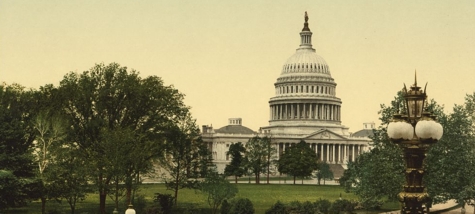 The US Capitol today has every modern convenience. I have several times had to explain to visitors that the they will not need to leave the Capitol to make a phone call, that it has excellent reception throughout. This interest in having the most modern of technologies has been true for its entire life, and today I look at a technology that was used in the latter half of the 19th century to light the work of Senators and Congressmen: gas.
The US Capitol today has every modern convenience. I have several times had to explain to visitors that the they will not need to leave the Capitol to make a phone call, that it has excellent reception throughout. This interest in having the most modern of technologies has been true for its entire life, and today I look at a technology that was used in the latter half of the 19th century to light the work of Senators and Congressmen: gas.
When the US Capitol was first built, there was no centralized method for lighting the chambers at night. Light was supplied by whale oil lamps. This was hardly the best form of lighting, so when gas was piped through the city, the Capitol was soon added to those connected to the system. It took an enormous amount of gas to light the Capitol, which, by 1865, had 1,083 gas jets lighting just the rotunda (according to William C. Allen’s “History of the United States Capitol”). The amount of gas used was so great that if Congress had a late-night session at the same time as the White House held a gala, there was not enough gas to keep DC alight.
 It was therefore hardly surprising that the Architect of the Capitol would search for better ways of lighting their most important building. First attempts at using the new technology of electricity begun in the 1880’s, and though the first lights were deemed to flicker too much, both the House and Senate chambers were lit by electricity by 1896.
It was therefore hardly surprising that the Architect of the Capitol would search for better ways of lighting their most important building. First attempts at using the new technology of electricity begun in the 1880’s, and though the first lights were deemed to flicker too much, both the House and Senate chambers were lit by electricity by 1896.
Then, as now, change comes slowly, and – as was normal at the time – the Capitol continued to use both electricity and gas for lighting. Chandeliers wired for both technologies continued to be used. (Houses on the Hill relied on both gas and electricity well into the 20th Century as well.)
It was to take a cataclysmic event to change the status quo. The impetus came on the evening of November 6, 1898. On that day, a gas meter in the basement of the Capitol began leaking, and gas filled the basement, slowly rising to the level of a gaslight left on to allow watchmen to attend to their rounds. At 5:30 PM, the gas reached the light, setting off a tremendous explosion that was witnessed by two policemen three blocks away. The fire raced up an elevator shaft, blowing plaster, brick, and marble in all directions.
The National Tribune printed the Thursday after the event describes what happened.
Above the meter were strong arches of masonry, and immediately above where the explosion took place the walls are cracked. Notwithstanding this, the entire floor of the corridor leading to the Law Library, on the basement or ground floor, is completely torn up, and lies scattered and in heaps upon the floor of the sub-basement.
The fire started near the crypt directly north of the rotunda, and most of the damage affected the Supreme Court chambers. Initial reports asserted that the Supreme Court had lost most of its papers; this turned out not to be true, though some opinions were damaged beyond repair. Amazingly enough, nobody was injured by the blast.
In the end, 20 tons of rubble were removed from the Capitol, and when the repairs had been completed, the Capitol was also lit entirely by electricity.

When does the Capitol get solar panels?